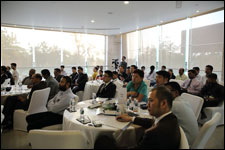India is sitting on untapped
mineral reserves of over 80 billion tons but despite the country’s huge resource base and geological advantages, the domestic mining sector has not been able to fully exploit their potential due to infrastructure related constraints as well as social and regulatory bottlenecks, revealed a recently released study by the Associated Chambers of Commerce and Industry of India.
“With its substantial reserves of natural resources, India needs to embark upon sustainable best practices in mining to get best results in the sector, besides strict enforcement of mining laws is also imperative as better enforcement rather than more regulation can help remedy the ills plaguing Indian mining sector,” said the ASSOCHAM study focused on ‘Restoring Normal Operations in Mining’.
Releasing the study,
ASSOCHAM President Rana Kapoor said the domestic mining sector held huge growth potential in India’s economy but it was saddled with various economic, bureaucratic, environmental and capacity issues.
“With China ramping up its domestic production, India is facing a stiff competition as it seems very difficult for it to match the scale and cost of production with that of its counterpart,” said Kapoor.
He pointed out that given the volatile nature of the
mining industry, it was not possible to predict commodity demand or price movements. Hence, he stressed, Indian players needed to keep in mind various scenarios while preparing mine development plans.
“As Indian players expand their operations (domestic or global), they should explore strategies to build strategic portfolios (either by themselves or through strategic joint ventures/consolidation), synergies of which could be leveraged to match demand/supply imbalances,” he said.
Kapoor also emphasized the need to improve operational efficiency in Indian mining companies since issues like rampant over-extraction from mines and illegal possession of land for mining had become major concerns for the sector. He underlined that the issues, if not addressed suitably, could take the sector backward.
“There is also the need to formulate a public policy in mining which enables inclusive sustainable development by sharing the benefits derived from mineral resources with the community at large as it would positively affect the growth outlook of the sector,” he said.
The ASSOCHAM study highlighted the need to correct the regulatory anomalies that currently exist in order to build an environment conducive for commercially viable mining. It was crucial for stakeholders to understand global trends and likely implications so as to evolve a growth oriented approach, it said.
The study further noted that it was imperative for domestic mining companies to reduce costs in a sustainable manner through measures such as improving productivity, strengthening management and reporting systems, using analytics to uncover underlying cost drivers and rationalizing supply chains and others. It also called for adoption of innovative strategies such as automation, investment in
transport and logistics, increasing use of technology in mine design and sharing of infrastructure and other resources.
To deal with the hindrances faced in carrying out mining activities due to infrastructure related constraints and procedural delays resulting in capital blockage, the study suggested that companies focus on developing skill sets, both internal and external, in order to grow their capital project portfolios in a strategic manner (phased development, diversification, use of new technologies) and put in place proper financing arrangements to prevent financial impairment in case of project delays.
The study said that considering the local economic, social and
environmental effects of mining activities, it was important for companies to integrate risk-based corporate social responsibility strategies and develop and track those in the same manner as done for production.
“Until CSR is considered a direct business risk, mining companies will struggle to minimize the probability and financial impacts of these risks,” it said.
On shortage of talent for executive positions in mining companies, the study said it was likely to increase in the future.
“Mining companies require new talent management strategies, besides miners should standardize systems, embrace new training environments and take necessary steps to attract both skilled management and tech-savvy directors,” it said.
.jpg)








